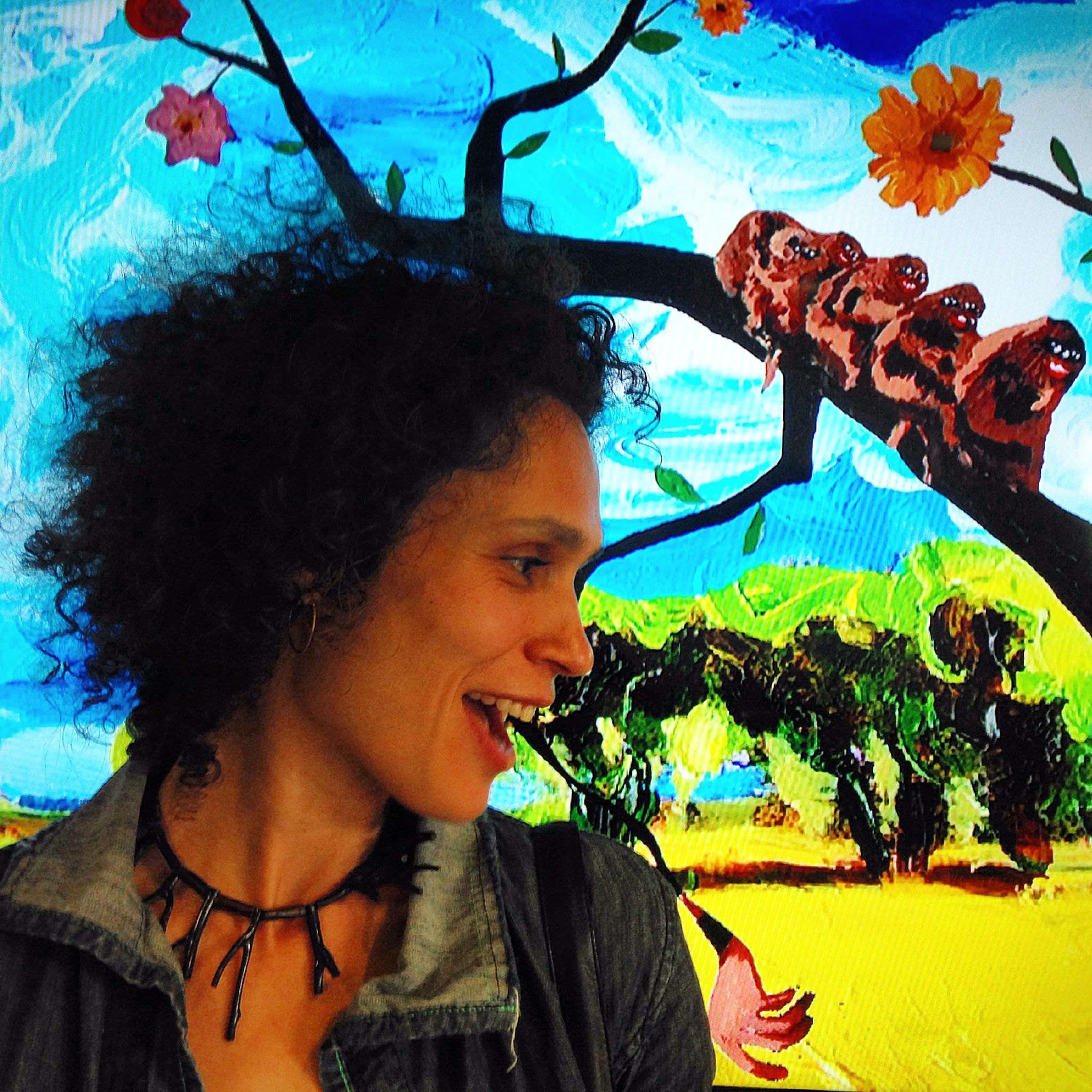by Yuko Oda
Yuliya Lanina is a Russian born multimedia artist exploring the human psyche through a genre-defying interweaving of painting, animation, robotics, and performance. I had the pleasure and honor to have an in-depth conversation with Yuliya about her most recent performance pieces which transported me into otherworldly landscapes of darkness and beauty. http://www.yuliyalanina.com/
Yuko Oda (YO): What artworks are you exhibiting in Creative Tech Week 2019?
Yuliya Lanina (YL): I will be premiering Misread Signs, a multimedia performance done in collaboration with composer José Martínez and choreographer Andrea Ariel. It will feature movement, sound and my animatronic sculptures and projected animation based on my paintings. The piece explores the effects of trauma on the human psyche. It will premiere at Five Myles gallery, 558 ST JOHNS PLACE, Brooklyn, NY on May 8th, at 7pm.

I will also be participating in the CTW2019 Conference Hub with Biocurious, an animatronic child-doll which opines on the human-robot relationship. This piece will be exhibited at the CTW2019 Conference Hub on May 10th and 11th 2019, 10am-5pm at NYIT Auditorium on Broadway, 1871 Broadway, NY. The piece was made with the support of The Foundry at The University of Texas at Austin and with technical development support by Theodore Johnson.
YO: Yuliya, I have followed your work for over a decade, and performance seems to be a relatively new emergence in your work, which is very exciting. Could you explain how performance affects the message of your work, and how and when it has evolved in your art-making? How does performance strengthen your message?
YL: I always wanted to be a performer since I was a child. I loved singing and whenever I could find an audience I would perform for them. I remember singing at the hospital where my mother worked for her coworkers during lunch hour, for the hairdressers when my mother’s hair was being cut. Life circumstances did not allow me to entertain this as a career path. I suppose that part of me which always wanted to perform is finally coming out now. It took a few decades, though it feels right this time and I’ve learned to follow my intuition.
My work is very personal. I always look for ways to interact with the viewer directly. Performing in consort with my visual work in front of an audience is the most intimate and immediate way of connecting with the audience. It is also exhilarating to interact with my work on stage in real time and become one with it during a performance. There is something about the immediacy, vulnerability and the impermanence of that shared experience that is both exciting and terrifying. It enables me to both reach the audience and connect with my work on a new level.
YO: Can you tell me a little about your first performance piece Not a Sad Tale? It is wonderful how the position of the objects is mapped to your body in the piece. For example, the butterfly of the animation lands on your actual hand.

YL: Exactly. This is done by video production and projection that is made to fit my size and it took a lot of tries to get it right. The visuals often come first. When creating the animation, I had an idea of where I’d like to be in relation to my work and what type of costumes I might wear. After the video is done or partly done, I met with choreographer and composer. Andrea Ariel, with whom I’ve been working on all of my performance pieces, helped me decide on movement and placement. There was a lot of back and forth based on her and Vladimir Rannev’s (composer) input. Then I went back to the video production to adjust the imagery, and bring in the audio. The same process was for my following performance piece Within, Above and Beyond, which I’ve performed at CTW last year.
A lot of work goes into making each piece. The sad part is that after all of the effort, the piece is over in 20 minutes. But the collective experience and engaging my work in real time that is truly magical.
YO: One thing I am wondering about is your make up and gestures and moves in the performance… and your costumes. Are they all decided by you or are you working with choreographers?
YL: I decide on the costumes as I work on the piece, about halfway in the process. They are crucial to setting the tone of a performance. My costumed character often appears on the screen as well. In Misread Signs in addition to wearing a costume, I painted my face, bringing the painting, which serves as a foundation for my animations, into the costume.
YO: Where do you show your work? How does that inform the size of your projections?
YL: I started performing in gallery spaces, having a wall determine the size of my projections.
Then I started to be invited to large festivals such as SIGGRAPH and SXSW instead of galleries. At the music festivals, where I am on the stage and there is a huge screen behind me, I realized I can have an even larger impact with if I did not limit the size of my projected video. For this new piece I decided to make the video much larger.
Following the CTW performance of Misread Signs, where it will be projected only on one wall, the piece will be featured at the grayDUCK gallery in Austin, where it will take up the whole room, making it more immersive. For that performance I will be using three projections on three adjacent walls. Once again, I am including animatronic sculptures – plastic anthropomorphic skeleton birds with human baby heads, lights shining out of their pupils, their presence adding more ambience to the piece.
YO: That is so wonderful, Yuliya. It is brilliant – you have a lot of flexibility with scale because it is video, not a painting or a physical object.

YL: Exactly. I first experimented with this while making films with robotic dolls. With the projection I was able to manipulate the size, make something small look huge and impactful. I took the same approach to my stop-motion animations, where an enlarged image makes it easy to interact with while preserving the painterly quality. My paintings serve as source materials for all of my animations; you can see the brushstrokes and the hand drawn textures in the projected videos that cannot be replicated.
YO: So how long is this piece?
YL: Most of my performances, including this one, are around 16 minutes, which seems short. Yet, being on stage for 16 minutes feels like an eternity.
YO: How much of the paintings are you making for this new piece vs. pieces you are re-appropriating from your portfolio.
YL: Almost all of these are new paintings I made over the past year. These paintings will be displayed at the grayDUCK show. It is always great to see the direct relationship between the paintings on the wall and animations.
YO: It is really powerful, because it’s all very custom for this particular story.
YL: I make work based on what I am experiencing or working through in my life. Whatever work I make determines how the story unfolds. Then I let the process evolve naturally.
YO: Your children participated in your previous performance and you are planning to include them in one of the performances for Misread Signs as well. Can you tell me the significance of having your children in your work?

YL: My work stems from my life experiences, and since my children are an integral part of my life, I wanted them to play a part somehow – they just needed to be old enough to want to do it and be reliable.
Last summer, I finally included them in a performance (This is a Test of Internal Emergency Broadcast System). It wasn’t easy; luckily, Andrea Ariel (the choreographer) had a lot of experience working with children and had my twin girls engaged in no time. They even chose costumes. When it came to the performance, I had to let go of being their mother and embrace unpredictability.
Before the actual performance, I told them whatever happens, just keep going and go until the end. And they were amazing! They did everything they were supposed to do. Anya was so responsible. She just sat there and waited for the performance to start. She was so still, that the audience thought she was a doll. Then, in the middle of the performance, she moved, and the audience was startled!
After that performance, I saw my children in a different light. Not as my children but as my collaborators that I can rely on. It was strangely gratifying!
YO: I have known you for a long time and I know some of the themes you mention is personal and your current piece, Misread Signs, is particularly so. Can you talk about it?

YL: With this piece, I wanted to investigate a moment in my life when after a traumatic experience I became mute for a few days. And it stayed with me for some time. Maybe I didn’t have the right words to describe what it was, or maybe there were no words that could describe what I was feeling – it was too overwhelming. Here, I am examining this inability to express and even connect with how they feel.
The piece also explores my complicated relationship with my mother, and with her emotional and physical absence. She passed away when I was 19 after a long battle with cancer.
My collaborator, composer José Martinez uses recordings of my voice as his audio material and renders what I say or sing beyond recognition, transforming my voice to the extreme in order to convey the urgency of expression. There are a few times when I address the audience directly, asking them to reflect on their own past. The piece ends with a modified lullaby sung to my mother and remembrance of those who passed away.

I hope the show will transcend the particulars of my life experience into a universal story of perseverance and asks us to reflect on our connection to ourselves, to each other and to those who are no longer with us.
Yuko Oda is a multimedia artist living and working in Boston, MA. She is currently investigating synthetic nature and the intersection of art and technology. She teaches at the University of Massachusetts Lowell. www.yukooda.com

